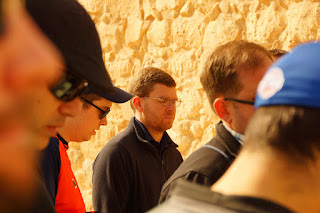
Tel Arad is located south of Jerusalem, in the north of the Negev desert. The Tel (an archaeological mound) is on the boundary between the northern part of the desert proper and the southern most arable lands in Israel. It occupies a defensible position on a hill in the middle of a large plain, from which enemies could be seen a long way off.
The city’s origins stretch back nearly 6,000 years to the Canaanites who occupied the land and built a small settlement that grew over the years into a city. For some reason it was abandoned from about 2600 B.C until the Israelites occupied it and built a fortress on the very top of the hill, sometime around the beginning of the united Kingdom under David and Solomon, 1000 B.C.

For myself, the real significance of the place lies in presence of a temple within the fortress. Here, our forefathers-in-faith bloodily sacrificed animals to God according to the Law. Here they practiced their faith in a Temple that provides the theological underpinnings of our own churches. Here, the temple layout is clearly visible: a sacred space with a courtyard with an altar built of un-hewn stones, a sanctuary and Holy of Holies in which are two small altars for burning incense and the stones which indicate the presence of God(s). The whole temple is remarkably small, occupying an area about 30-by-30 feet.

In Tel Arad, far from Jerusalem by land but close by faith, the Chosen People worked out their faith in God. They had to deal with other pagan religions and live side by side with them. This same reality is with us today as inheritors of the fulfillment of the Promise given to the Israelites. As I left Tel Arad, I had a newfound appreciation for the gift of water. I also had a question: How am I going to live out my faith as a priest of the New Covenant of Jesus Christ in a world of diverse religions?



No comments:
Post a Comment